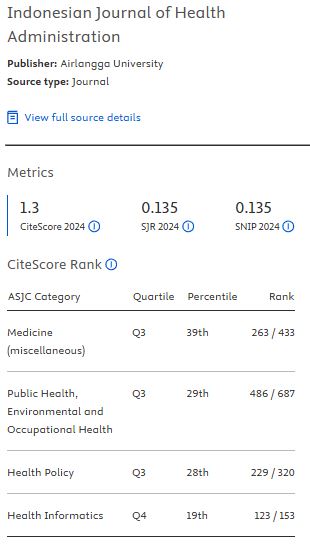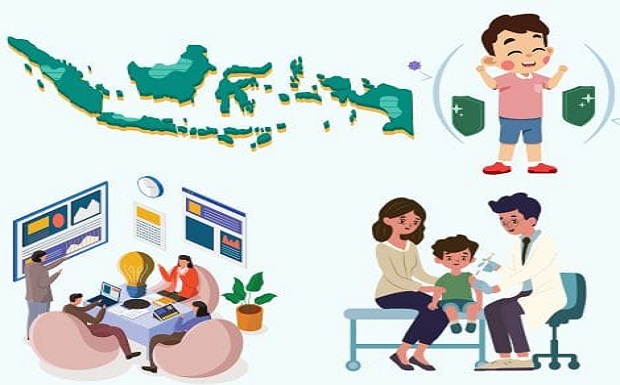STRENGTHENING MATERNAL AND CHILD HEALTH SYSTEM TOWARDS INDONESIA EMAS 2045
Downloads
This editorial article highlights the important role of strengthening the maternal and child health system for the overall increase of the nation’s productivity, as well as the achievement of Indonesia Emas 2045. The discussion emphasized accessibility of maternal health services in community health services like Posyandu through readiness of health cadres, especially after the government implemented Integrated Primary Health Services or Integrasi Layanan Primer (ILP). Moreover, the implementation of exclusive breastfeeding was found to be significantly associated with stunting, making it a pivotal program to decrease stunting prevalence and increase infants’ health quality. Although some challenges like geographic barriers, limitation of knowledge and education, as well as low household income existed, investing in the maternal and child health system would solve the problem of the high mortality rate among mothers and infants. As Indonesia Emas 2045 was set as national development goals, the article stands up for better quality of maternal and child health in Indonesia through collaboration across sectors with an inclusive decision-making process.
Keywords: Child health, health system, infant health, maternal health.
Badan Pusat Statistik (2019) Laporan Pelaksanaan Integrasi Susenas Maret 2029 dan SSGBI tahun 2019. Jakarta.
Bancin, L.J. et al. (2025) ‘Systematic Literature Review: Exclusive Breastfeeding and Stunting – a Preventive Approach for Health Policy’, Jurnal Administrasi Kesehatan Indonesia, 13(1), pp. 110–124. Available at: https://doi.org/10.20473/jaki.v13i1.2025.110-124.
Barborra, S. (2023) ‘Investing in Maternal Health: Economic Benefits and Policy Implications’, Journal Of Contemporary Medical Education, 13(9), pp. 1–7.
Laksono, A.D. et al. (2025) ‘Can Education Increase NHI Membership? A Case Study Among Madurese in Indonesia’, Jurnal Administrasi Kesehatan Indonesia, 13(1), pp. 9–19. Available at: https://doi.org/10.20473/jaki.v13i1.2025.9-19.
Latifah, L. et al. (2025) ‘The Role of Prenatal Classes in Exclusive Breastfeeding: Evidence from Papua, Indonesia’, Jurnal Administrasi Kesehatan Indonesia, 13(1), pp. 82–97. Available at: https://doi.org/10.20473/jaki.v13i1.2025.82-97.
Siswati, T. et al. (2025) ‘Assessing Posyandu Cadres’ Readiness in Implementing Integrated Primary Health Services in Yogyakarta, Indonesia’, Jurnal Administrasi Kesehatan Indonesia, 13(1), pp. 44–57. Available at: https://doi.org/10.20473/jaki.v13i1.2025.44-57.
Stephenson, T. (2024) ‘Importance and benefits of investing in child health and research’, Global Pediatrics, 9, p. 100217. Available at: https://doi.org/10.1016/j.gpeds.2024.100217.
Suparmi et al. (2018) ‘Subnational regional inequality in the public health development index in Indonesia’, Global Health Action, 11(sup1), pp. 41–53. Available at: https://doi.org/10.1080/16549716.2018.1500133.

This work is licensed under a Creative Commons Attribution-ShareAlike 4.0 International License.
1. As an author you (or your employer or institution) may do the following:
- make copies (print or electronic) of the article for your own personal use, including for your own classroom teaching use;
- make copies and distribute such copies (including through e-mail) of the article to research colleagues, for the personal use by such colleagues (but not commercially or systematically, e.g. via an e-mail list or list server);
- present the article at a meeting or conference and to distribute copies of the article to the delegates attending such meeting;
- for your employer, if the article is a ‘work for hire', made within the scope of your employment, your employer may use all or part of the information in the article for other intra-company use (e.g. training);
- retain patent and trademark rights and rights to any process, procedure, or article of manufacture described in the article;
- include the article in full or in part in a thesis or dissertation (provided that this is not to be published commercially);
- use the article or any part thereof in a printed compilation of your works, such as collected writings or lecture notes (subsequent to publication of the article in the journal); and prepare other derivative works, to extend the article into book-length form, or to otherwise re-use portions or excerpts in other works, with full acknowledgement of its original publication in the journal;
- may reproduce or authorize others to reproduce the article, material extracted from the article, or derivative works for the author's personal use or for company use, provided that the source and the copyright notice are indicated.
All copies, print or electronic, or other use of the paper or article must include the appropriate bibliographic citation for the article's publication in the journal.
2. Requests from third parties
Although authors are permitted to re-use all or portions of the article in other works, this does not include granting third-party requests for reprinting, republishing, or other types of re-use.
3. Author Online Use
- Personal Servers. Authors and/or their employers shall have the right to post the accepted version of articles pre-print version of the article, or revised personal version of the final text of the article (to reflect changes made in the peer review and editing process) on their own personal servers or the servers of their institutions or employers without permission from JAKI;
- Classroom or Internal Training Use. An author is expressly permitted to post any portion of the accepted version of his/her own articles on the author's personal web site or the servers of the author's institution or company in connection with the author's teaching, training, or work responsibilities, provided that the appropriate copyright, credit, and reuse notices appear prominently with the posted material. Examples of permitted uses are lecture materials, course packs, e-reserves, conference presentations, or in-house training courses;
























